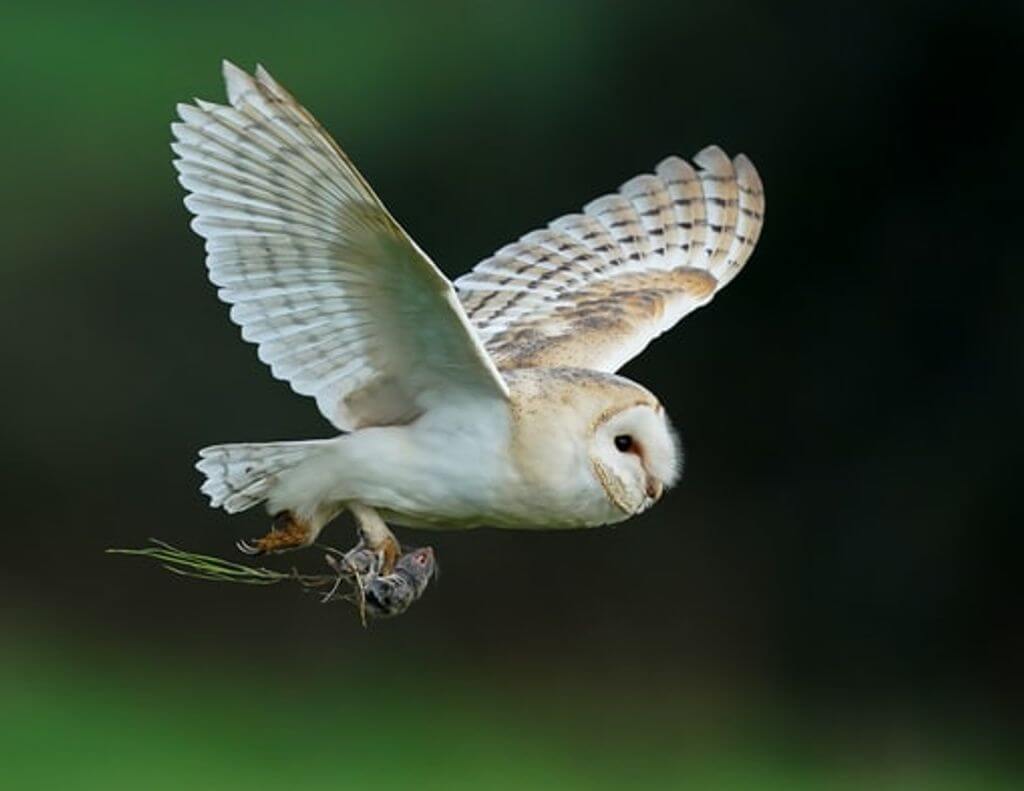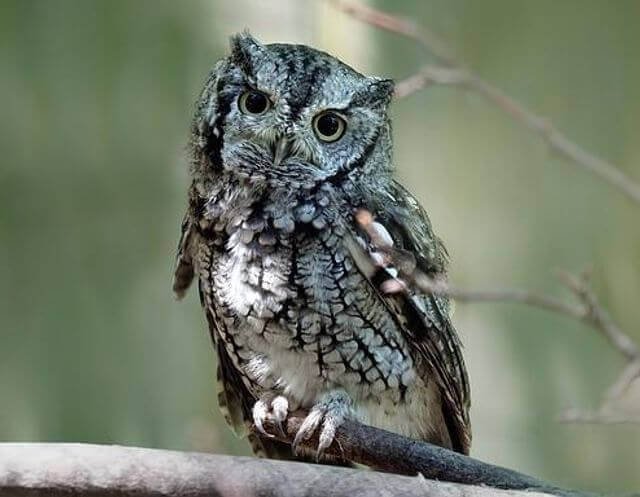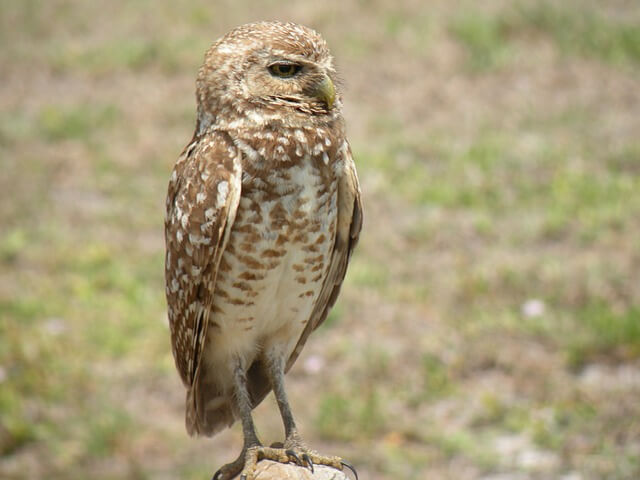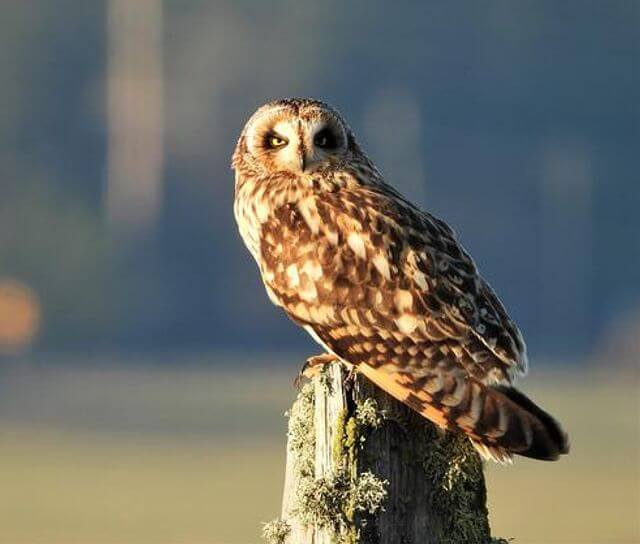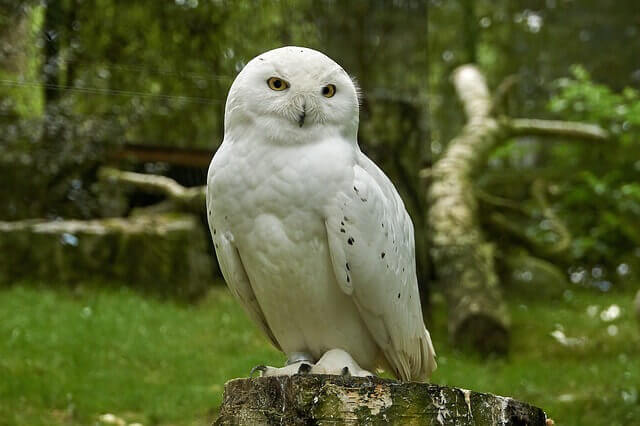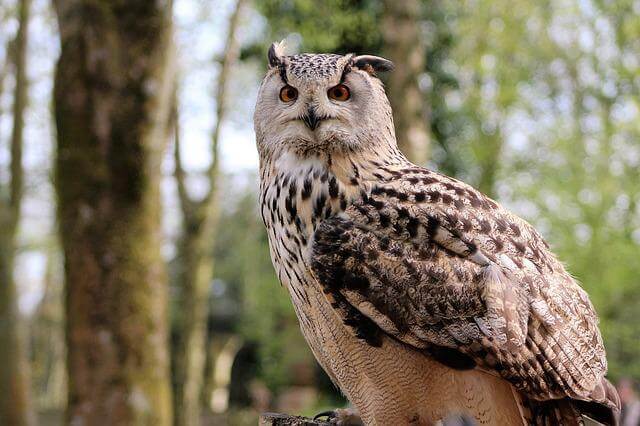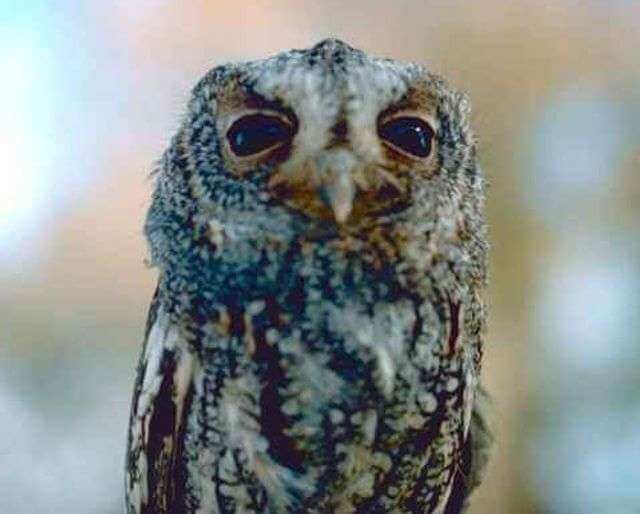Owls are one of the most popular bird species for birdwatchers. They are nocturnal, so most people only get to see them during the night. There are many owls in Florida, and each has its own unique features that make it an interesting species to watch.
In this article, we will introduce you to 10 species of owls in Florida and provide information on their ID, frequency, and where they can be found.
Table of Contents
Types of Owls in Florida
Barred Owl
- Length: 16.9-19.7 in (43-50 cm)
- Weight: 16.6-37.0 oz (470-1050 g)
- Wingspan: 39.0-43.3 in (99-110 cm)
- Scientific Name: Strix varia
- Frequency of Occurrence: 3.77% (Statistic by: eBird)
- Where To Find Them: The panhandle, north central Florida, and the Tampa Bay area are all good places to see these owls.
- How to Attract: If you are looking to attract a barred owl to your property, there are a few things you can do. First, make sure you have a large tree or trees on your property that offer plenty of roosting and nesting spots. You can also provide a water source, such as a pond or creek, to attract the owls. Finally, make sure your property is not disturbed by humans or pets, as this can scare away the owls.
The Barred owl is a medium-sized owl that is found in North America, Central America, and South America. In the United States, the barred owl is found in the eastern half of the country west to Texas.
The barred owl’s habitat includes forests, woodlands, and swamps. The diet of the barred owl consists mostly of small animals such as rodents, rabbits, snakes, insects, and fish.
Great-horned Owl
- Length: 18.1-24.8 in (46-63 cm)
- Weight: 32.1-88.2 oz (910-2500 g)
- Wingspan: 39.8-57.1 in (101-145 cm)
- Scientific Name: Bubo virginianus
- Frequency of Occurrence: 1.76%
- Where To Find Them: Some good areas to see them include the Ocala National Forest, the Everglades National Park, and along the St. John’s River.
- How to Attract: Great-horned owls can be attracted to your property by providing a food source such as a live trap with mice or rats, or by putting up a nest box. If you live in an area where great-horned owls are present, it’s also a good idea to keep an eye out for their droppings, which are pellet-shaped and black in color.
The Great-horned owl is a large, predatory bird that ranges throughout North and South America. The great-horned owl typically inhabits woodlands, deserts, and prairies, but can also be found in urban areas.
These owls primarily eat small mammals such as rabbits, hares, and rats, but they will also consume birds, reptiles, and amphibians. Great-horned owls are very adaptable and can survive in a variety of habitats.
Related Post: 35 Fun Facts About The Great Horned Owl (Detailed)
Eastern Screech Owl
- Length: 6.3-9.8 in (16-25 cm)
- Weight: 4.3-8.6 oz (121-244 g)
- Wingspan: 18.9-24.0 in (48-61 cm)
- Scientific Name: Megascops asio
- Frequency of Occurrence: 0.8254%
- Where To Find Them: Eastern screech owls inhabit many parts of Florida, but there are a few specific areas where they can be found in higher concentrations. One such place is the Paynes Prairie Preserve State Park in Gainesville. This large park is home to a variety of wildlife, including deer, alligators, and plenty of birds. The screech owls can often be seen perched in the trees or swooping down to catch prey. Another great spot for spotting these owls is around Lake Kissimmee. This large lake is located in central Florida and is a popular spot for fishing and birdwatching. The screech owls can be found near the edges of the forest surrounding the lake or perched in tall cypress trees.
- How to Attract: If you want to attract an eastern screech owl to your backyard, you can provide a nest box. The dimensions of the box should be about 10×12 inches with a 6-inch opening. It’s important to place the box in a location that is sheltered from the weather and predators. You can also create a roosting spot for the owl by piling up some branches in a shady spot. The best way to attract an eastern screech owl is by providing them with food. They are insectivores, so they mainly eat insects, but they will also eat small mammals, birds, and reptiles.
Eastern screech owls are a small owl species that is found in eastern North America. These owls are known for their distinct “screeching” call, which is how they got their name. Eastern screech owls typically inhabit wooded areas, where they can find plenty of prey to hunt.
These owls mainly eat small mammals, such as rodents, but they will also eat birds, reptiles, and insects. Eastern screech owls are a common sight in backyards and parks, and they can often be seen perched on tree branches or hunting from a perch.
Burrowing Owl
- Length: 7.5-9.8 in (19-25 cm)
- Weight: 5.3 oz (150 g)
- Wingspan: 21.6 in (55 cm).
- Scientific Name: Athene cunicularia
- Frequency of Occurrence: 0.5084%
- Where To Find Them: They can be found in a few different areas throughout the state, but some of the best spots are the Merritt Island National Wildlife Refuge, the St. Marks National Wildlife Refuge, and Paynes Prairie Preserve State Park.
- How to Attract: Burrowing Owls can be attracted to your property by providing an appropriate habitat and food source. To create a suitable habitat, you will need to provide open areas for foraging and nesting, as well as some cover from the sun and predators. You can do this by leaving un-mowed areas of your lawn, planting native shrubs and trees.
The Burrowing Owl is a small, stocky owl with long legs and a short tail. It is the only owl in North America that lives almost exclusively in open country. The Burrowing Owl ranges from Alaska and Canada to Central America. In the United States, it is found in western states as far east as Texas and Kansas.
Burrowing Owls live in open habitats such as prairies, grasslands, desert scrub, and agricultural land. They are also found in wetlands, including marshes and riparian areas. Burrowing Owls nest in underground burrows that they excavate themselves or use those dug by other animals such as prairie dogs or ground squirrels.
Related Post: Really Cool Burrowing Owl Facts That Will Amaze You!
Barn Owl
- Length: 12.6-15.8 in (32-40 cm)
- Weight: 14.1-24.7 oz (400-700 g)
- Wingspan: 39.4-49.2 in (100-125 cm)
- Scientific Name: Tyto alba
- Frequency of Occurrence: 0.2740%
- Where To Find Them: They can be spotted along the Gulf Coast and in the Florida Keys, as well as in wetlands, marshes, and agricultural areas.
- How to Attract: The best way to attract barn owls is to provide them with a nesting site and a food source. A nesting site can be anything from a natural hole in a tree to an artificial nest box. The best food for barn owls is rodents, but they’ll also eat other small animals, such as birds, lizards, and insects. If you want to try to attract a barn owl to your property, you should place some rodent bait near their nesting site or food source.
The Barn owl is a common, widespread bird of prey found in open country across the world. In North America, they are most commonly found in agricultural areas and along the edges of forests. They are also frequently spotted near wetlands.
Barn owls typically eat small mammals such as rodents, but will also take birds, lizards, and other reptiles. They hunt mainly at night, using their acute sense of hearing to locate prey. Barn owls have a wingspan of about 4 feet and can weigh up to 2 pounds.
Short-eared Owl
- Length: 13.4-16.9 in (34-43 cm)
- Weight: 7.3-16.8 oz (206-475 g)
- Wingspan: 33.5-40.5 in (85-103 cm).
- Scientific Name: Asio flammeus
- Frequency of Occurrence: 0.0254%
- Where To Find Them: In Florida, they can be found in the Panhandle and along the Gulf Coast. They are also common in the Everglades.
- How to Attract: In order to attract short-eared owls, you should provide a safe place for them to roost and hunt as well as food sources.You can create a nesting box for short-eared owls by using a 12-inch diameter, deep metal garbage can with the bottom cut out. The top of the nesting box should have a 2×4-inch hole that is 8 inches high and 10 inches wide. The hole should be covered with wire mesh to keep predators out.
The short-eared owl is a medium-sized owl that ranges in length from 13 to 17″ inches and has a wingspan of 33 to 44″ inches. This owl can be found in open areas such as prairies, meadows, and fields, as well as in agricultural areas and marshes.
The diet of the short-eared owl consists mainly of small mammals such as mice, voles, and rabbits, but they will also eat birds, reptiles, amphibians, and insects. This owl is most active at dusk and dawn and can be seen perched on fence posts or telephone poles waiting for its prey to come out.
Snowy Owl
- Length: 20.5-27.9 in (52-71 cm)
- Weight: 56.4-104.1 oz (1600-2950 g)
- Wingspan: 49.6-57.1 in (126-145 cm)
- Scientific Name: Bubo scandiacus
- Frequency of Occurrence: 0.0084%
- Where To Find Them: Snowy Owls are an interesting bird to see and are often seen in areas where they are not expected. In Florida, Snowy Owls can be found in the northern panhandle near Pensacola and also in the central part of the state near Lakeland and Orlando. They have also been spotted in Miami, but this is rare. Snowy Owls typically stay in colder climates such as Canada and the northern United States, but during some years they will migrate further southward into warmer areas like Florida.
- How to Attract: If you want to attract a snowy owl to your property, there are a few things you can do. One way to attract them is to provide a food source. Owl pellets, which are the regurgitated remains of their prey, can be purchased from birding stores or online. You can also put out live prey such as mice or rats. Another way to attract snowy owls is to create a perch for them. A platform made of wood or metal with a rough surface works best. The perch should be placed in an open area where the owl will have a clear view of its surroundings. Finally, make sure you provide some shelter for the owl.
Snowy Owls are one of the most iconic birds in North America. These owls can be found in the tundra and boreal forests of the Arctic. They are well-adapted to life in cold climates, with their thick plumage and white coloration that helps them blend into the environment.
Snowy Owls are opportunistic hunters, feeding on a variety of prey items including small mammals, birds, and fish. They may also feed on carrion.
Related Post: 48 Fun Facts About Snowy Owls (with Photos, ID & Info)
Long-eared Owl
- Length: 13.8-15.8 in (35-40 cm)
- Weight: 7.8-15.3 oz (220-435 g)
- Wingspan: 35.4-39.4 in (90-100 cm)
- Scientific Name: Asio otus
- Frequency of Occurrence: 0.0001%
- Where To Find Them: They are usually seen in open areas where they can find plenty of prey to hunt. Some good places to see them in Florida include Paynes Prairie Preserve State Park, Ocala National Forest, and Everglades National Park.
- How to Attract: Provide a safe place for them to land. Snowy owls like wide open spaces, so provide a large area for them to perch or land. A flat roof or high platform is ideal. Offer plenty of food. These owls eat mostly small rodents, so offer them a lot of live mice or rats. You can also put out owl pellets, which are the undigested remains of prey that have been regurgitated by the owl.Create some shelter from the wind and cold.
The long-eared owl is found in North America, Europe, and Asia. In North America, the long-eared owl is found in the east from Nova Scotia south to Florida and west to Texas. In the west, the long-eared owl is found in British Columbia and Alberta. The long-eared owl is also found in Europe and Asia. The long-eared owl prefers dense forests with a lot of trees and understory.
They can also be found in open areas with scattered trees or bushes. The long-eared owl hunts during the day and night, so they need a variety of habitats to find prey. The diet of the long-eared owl consists of small mammals such as mice, voles, and rabbits; as well as birds such as songbirds and waterfowl.
Flammulated Owl
- Length: 5.9-6.7 in (15-17 cm)
- Weight: 1.5-2.2 oz (43-63 g)
- Wingspan: 15.9-16.1 in (40.5-41 cm).
- Scientific Name: Otus flammeolus
- Frequency of Occurrence: 0.0000%
- Where To Find Them: In Florida, they are found in the Panhandle and Big Bend areas.
- How to Attract: There are several things you can do to increase your chances of attracting a Flammulated Owl. First, find an area that has plenty of tall trees for the owl to perch in. Make sure there are also plenty of open areas for the owl to hunt in. Second, try to create a habitat that is similar to what the owl would find in nature. This means having a mix of trees and shrubs, as well as meadows and fields. Finally, provide some cover for the owl to hide in during the day. This could be a pile of logs, a rock pile, or even some artificial nesting boxes.
The Flammulated Owl is a small owl that is found in North America. This owl is the most common owl in the Rocky Mountains. The Flammulated Owl’s range extends from British Columbia to New Mexico.
This owl prefers dry, open forests and woodlands. The diet of the Flammulated Owl consists mostly of small mammals, such as mice, rats, and voles. This owl will also eat birds, insects, and other small prey.
Northern Saw-whet Owl
- Length: 7.1-8.3 in (18-21 cm)
- Weight: 2.3-5.3 oz (65-151 g)
- Wingspan: 16.5-18.9 in (42-48 cm)
- Scientific Name: Aegolius acadicus
- Frequency of Occurrence: 0.0000%
- Where To Find Them: In Florida, they can be found in the Panhandle and in the northern part of the state. They like to live in forests near water, and they are most active at night.
- How to Attract: They can be attracted to your backyard if you provide them with the right habitat and food. To attract Northern Saw-whet Owls, you will need to provide them with a safe place to live and plenty of food. These owls prefer dense forests, so you will need to create a habitat for them in your backyard. You can do this by planting trees and shrubs that provide cover, including evergreens, birch trees, and black cherry trees. You can also build a nesting box for the owls to use. Furthermore, you can also provide the owls with food by putting out bird feeders that offer owl pellets.
The northern saw-whet owl is a small owl that is a frequent inhabitant in North America. It is the smallest owl in North America and one of the smallest in the world. The northern saw-whet owl is found in Canada, the United States, and Mexico.
The owl prefers dense forests with plenty of trees for nesting and roosting. The diet of the northern saw-whet owl consists of small mammals, such as mice, rats, and rabbits, as well as insects.
Related Post: What is the Smallest Owl in North America?

